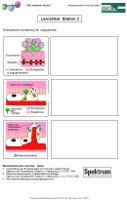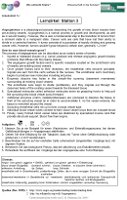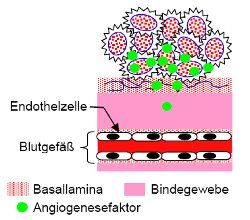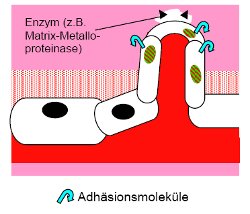Arbeitsblatt 7c: Lernzirkel Station 3

 Diese
Seite als PDF herunterladen
[PDF] [110 KB]
Diese
Seite als PDF herunterladen
[PDF] [110 KB]
Arbeitsblatt 7c: Lernzirkel Station 3
Angiogenesis is a physiological process describing the growth of new blood vessels from pre-existing vessels. Angiogenesis is a normal process in growth and development, äs well äs in wound healing. However, this is also a fundamental step in the transition of tumors from a dormant state to a malignant state. Cancer cells are cells that have lost their ability to divide in a controlled fashion. A tumor consists of a population of rapidly dividing and growing cancer cells. However, tumors wouldn't grow beyond a certain size, generally 1-2 mm^3.
How do new blood vessels grow?
The process of angiogenesis can be described as an orderly series of events:
- Injured or diseased tissues (e.g. tumor) produce and release angiogenic growth factors (proteins) that diffuse into the nearby tissues.
- The angiogenic growth factors bind to specific receptors located on the endothelial cells of nearby pre-existing blood vessels.
- Once growth factors bind to their receptors, the endothelial cells become activated. Signals are sent from the cell's surface to the nucleus. The endothelial cell's machinery begins to produce new molecules including enzymes.
- Enzymes dissolve tiny holes in the sheath-like covering (basement membrane) surrounding all existing blood vessels.
- The endothelial cells begin to divide (proliferate), and they migrate out through the dissolved holes of the existing vessel towards the diseased tissue.
- Specialized molecules called adhesion molecules serve äs grappling hooks to help pull the sprouting new blood vessel sprout forward.
- Additional enzymes (matrix metalloproteinases) are produced to dissolve the tissue in front of the sprouting vessel tip in order to accommodate it. As the vessel extends, the tissue is remolded around the vessel.
- Sprouting endothelial cells roll up to form a blood vessel tube.
- Individual blood vessel tubes connect to form blood vessel loops that can circulate blood.
- Finally, newly formed blood vessel tubes are stabilized by specialized muscle cells that provide structural support. Blood flow then begins.
Aufgaben:
- Nennen Sie je ein Beispiel für einen Wachstums- und Entwicklungsprozess, bei denen Gefäßneubildungen (= Angiogenese) stattfinden.
- Geben Sie eine Erklärung für die Tatsache, dass ein Tumor ohne Gefäßneubildung nicht größer als 1-2 mm3 werden kann.
- Beschreiben Sie die auf der nächsten Seite schematisch dargestellten Vorgänge kurz mit eigenen Worten.
- Benennen Sie das biologische Prinzip, das die Aktivierung von Endothelzellen bewirkt.
- Entwickeln Sie auf Basis der Vorgänge bei der Angiogenese eine Tumortherapie.
Glossar:
Angio - (von griech. aggeion = Gefäß), -genese (von griech. genesis = Entstehung)
blood vessel : Blutgefäß; dormant ruhend; tissue: Gewebe; to dissolve: lösen (chemisch)
adhesion : Anheftung; tip: Spitze; loop: Schlaufe
endothelial cell (= Endothelzelle): plattenförmige Zellen, die in einer einzigen Schicht die Blutgefäße auskleiden
basement-membrane (= Basallamina od. -membran): stabilisierende und isolierende Grenzschicht zwischen Epithel- und Bindegewebe
sheath-like : hüllenartig; grappling hook: Enterhaken; remold: umgestalten; sprouting: Sprossung
Quellen: (Dez. 2008)
1. http://www.angio.org/understanding/understanding.html
2. http://en.wikipedia.org/wiki/Angiogenesis
Lernzirkel: Station 3
Schematische Darstellung der Angiogenese:
|
|
|
|
|
|
|
|
|
Weiterführende Literatur - Links:
1. Ausschaltung der Blutversorgung von Tumoren, Judah Folkman, Spektrum der Wissenschaft, Spezial 2: Krebsmedizin, S. 91-96, 1996
2. Zielsichere Medikamente, Claudia Eberhard-Metzger, Spektrum der Wissenschaft, Spezial 3: Krebsmedizin II, s. S. 78-81, 2003
3. http://www.biochemweb.org/angiogenesis.shtml



